Adding UTM tracking to 123FormBuilder can be difficult, especially for those without coding skills.
Imagine if there were an easy way to capture UTM parameters into 123FormBuilder without any coding.
Meet Leadsources.io!
Leadsources is a tool that tracks lead sources and acts as a bridge between your UTM parameters and 123FormBuilder.

When someone clicks on your marketing campaign, Leadsources captures the UTM parameters in your URL.
Leadsources then inserts the UTM parameters into the hidden fields of your 123FormBuilder form.
You can view these UTM parameters along with the lead’s information on the leads submission page on 123FormBuilder.
Ready to set up UTM tracking in 123FormBuilder quickly? This guide shows you how to do it in just 10 minutes with Leadsources, no coding skills needed!
Implement UTM tracking in 123FormBuilder in 4 easy steps
Step 1: Add Leadsources to the head tag of your website

Sign up to Leadsources.io and enjoy a 14-day free trial.
Insert the Leadsources code into the head tag of your website. No coding or developers needed.
Just follow our simple step-by-step guide.
Step 2: Add UTM parameters to your campaigns

Add the UTM parameters you want to track in all your campaigns (PPC, email, social media, etc.).
Leadsources works with these UTM parameters:
- UTM_source
- UTM_campaign
- UTM_term
- UTM_content
Leadsources also captures data not included in UTM parameters, such as the channel, landing page, and landing page subfolder.
Step 3: Add hidden fields to your 123FormBuilder form

When visitors fill out your 123FormBuilder form, they provide personal data in visible fields (name, email, etc.).
Simultaneously, Leadsources automatically inserts UTM parameters into the hidden fields of your 123FormBuilder form (channel, source, etc.).
To do this, add hidden fields to your 123FormBuilder to store UTM parameters. Refer to this detailed guide to add the hidden fields to your 123FormBuilder form.
Add Hidden Fields:
- In the form editor, look for the option to add fields. This is usually on the left sidebar or in a toolbar.
- Click on “Add Field” or a similar button.
- Choose “Hidden Field” from the list of field types. This may be under a category like “Special Fields” or “Advanced Fields.”
- Add the exact following fields one by one:
- channel
- source
- campaign
- term
- content
- landingpage
- landingpagesubfolder
Step 4: Track UTM parameters in 123FormBuilder

When someone clicks on your campaign and visits your website, Leadsources captures the UTM parameters in your URL.
The visitor opens your 123FormBuilder form and starts filling it out.
Leadsources inserts the UTM parameters into the hidden fields of your form. These fields are invisible to the visitor.
When the form is submitted, the UTM parameters and form responses are submitted together. You can find all this information on the submission page on 123FormBuilder.
How does Leadsources work?
By adding the Leadsources code to the head tag of your website, Leadsources reads and captures UTM parameters in your URL whenever someone visits your site.
It then stores these UTM parameters in the hidden fields of your 123FormBuilder.
If a visitor arrives on your site without clicking a link with UTM parameters, Leadsources still captures data about the visitor using the referrer:
- Channel
- Source
- Campaign
- Landing page
- Landing page subfolder
This lets you track important lead source data, even without UTM parameters, like:
- On Google Search
- On your Instagram bio link
- On your social media posts
While many tools can only track lead sources using UTM parameters, Leadsources tracks the source of your leads regardless of where they come from:
- Organic Search
- Paid Search
- Organic Social
- Paid Social
- Referral
- Affiliate
- Display Advertising
- Direct Traffic
This facilitates the collection of lead source data in one place.
Pro tip:
LeadSources integrates with all the popular online form builders, including Cognito Forms, Gravity Forms, Jotform, Typeform, WPForms, and more. Check how to track the UTM parameters in any form builder.
How to run performance reports
Now that you have captured your lead source data in the hidden fields of your 123FormBuilder form, you can use it to run performance reports such as:
- Leads per channel
- Revenue per channel
- Revenue per keyword
This helps you make informed decisions on your marketing spending.
We’ll review the full range of reporting capabilities available to you.
Lead performance reports
You can run reports that show the number of leads generated by:
- Channel
- Source
- Campaign
- Landing page
- Landing page subfolder
Example #1
You run campaigns on different channels (SEO, PPC, emailing, etc.). Collect the data and generate the report: “Leads by Channel”.

Example #2
Once you discover the most effective lead-generating channel (e.g., Google Ads), you can investigate this channel to assess the lead generation results for each ad campaign.

Example #3
When you know which campaign is responsible for most of your leads, you can separate it and look at the specific keywords that contribute to the lead generation.

Sales performance report
Knowing which ads and keywords drive most of your leads is valuable, but do these ads and keywords contribute to your revenue?
By sending your 123FormBuilder submissions to a CRM, you can generate the same reports for sales.
Imagine the following example:
| Channels | Search Paid | Social Paid |
| Leads | 50 | 75 |
| Sales | 5 | 6 |
| Average order value | $150 | $100 |
| Revenue | $750 | $600 |
You ran ads on Google and Facebook, and the first report indicated that Social Paid ads had higher lead numbers compared to Search Paid ads.
However, after tracking which leads became paying customers, you found that Search Paid ads had a higher revenue return per lead, leading you to adjust your budget in favor of Search Paid ads.
LeadSources tracks the source of each lead in 123FormBuilder, whether they come from ads, organic search, social, email, etc. and syncs that data with each submission. See the full breakdown on the lead source in 123FormBuilder page.
